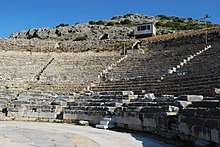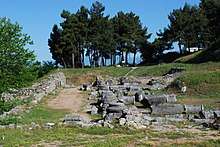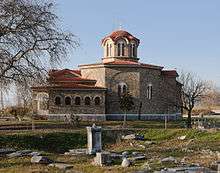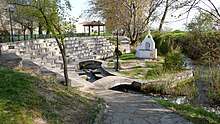Philippi
Philippi is an archaeological site in Macedonian Greece. It belongs since 2016 to UNESCO World Heritage List.



Understand
The archaeological site of Philippi is the most important in East Macedonia, with characteristic monuments of the Hellenistic, Roman and early Christian periods. Its story began in 360/359 BC, as colonists from the island of Thasos founded the city under the name Krenides.
In 356 BC, the inhabitants requested protection and support from King Philip II of Macedonia, as the city was threatened by the Thrakians. Philip had already foreseen the economic and strategic potential of the city, so he conquered and fortified it and renamed it Philippi, after himself.
After the Battle of Philippi in 42 BC, the city became a Roman colony. The bustling Hellenistic city of Philip II, whose walls, gates, theatre and some tombs are still visible, has been complemented by Roman public buildings such as the Forum and a monumental terrace with temples in the north. Its location on Via Egnatia, the ancient road linking Europe and Asia, furthered its development. Of particular importance in the history of Philippi was the year 49 or 50, when Apostle Paul visited the city and built the first Christian church in Europe and also performed the first Christian baptism. This made Philippi the first Christian community in Europe and a germ cell for the further development of Christianity in Europe. The remains of his basilicas provide an extraordinary testimony to the early establishment of Christianity. Therefore, there is also a lot of religious tourism here.
The decline began with the plague (547 AD) and an earthquake (AD 619), which almost completely destroyed the city and it never returned to its former importance. Around 850 AD, the Byzantine empire fought several wars with the Bulgarians for the city, which became Byzantine for itself finally, and strengthened the city in the 10th-11th century. After a brief occupation by the Franks after the Fourth Crusade, and the conquest of Constantinople in 1204, the city was conquered by the Serbs, and abandoned at an unknown time. During the occupation by the Ottoman Empire, it was used by the Turks as a quarry.
The excavations on the site of Philippi began in 1914 under the direction of the French Faculty of Archeology in Athens. After the Second World War, the excavations were resumed by the Greek Archaeological Society. Today, the archaeological excavations continue under the direction of the Greek Ministry of Archeology, the Aristotle University of Thessaloniki and the French Faculty of Archeology in Athens.
One may wonder about the ruins of so many churches in a small space. This is due to the fact that each of the temples of the former many gods had to be overbuilt by a church according to the Christian understanding.
Get in
Philippi is reached via Kavala (15 km) or Drama (25 km). All connections are described there. The buses to Philippi run on regularly schedule from the bus stations in Kavala or Drama.
Get around
All attractions are within walking distance.
See
The turnoff from the main road Kavala-Drama to Philippi is well signposted. You reach a large parking lot, which runs around a small park and is also suitable for campers. The restaurant in the park, with plenty of outdoor seating under trees, is the best place to rest after a visit to the ancient site. Since there is hardly any shade in Philippi, it can be quite warm during the visit in midsummer. The old Via Egnatia and later, the meanwhile disused federal road divides the area into two parts. The upper part is dominated by the ancient theater, the lower part by the remains of the city. One may wonder about the many churches on the relatively small excavation area, but each temple of the ancient religion had to be built with churches to prevent the worship of the ancient gods
During the summer, it is advisable to bring a headgear against the intense sun during the visit, since there are few shadows on the excavation site.
From the entrance you get directly to:
- 🌍 Theatre (No.2 on the map). It was probably built by King Philip II in the middle of the 4th century BC and extensively redesigned and completed by the Romans in the 2nd and 3rd centuries, so that the function of the theater could meet the needs of the performances of the time. It has been partially restored, and is used in summer for theatre and musical performances. The view from the ranks over the ruins and Pangaion Hills in the background is fantastic.
About 150 m further you can see the remains of a basilica, of which only the foundation stones remained:
- 🌍 Basilica A (No. 6 on map). It was a large, three-aisled basilica (130 x 50 m) with transept aisle on the east side, a square atrium, and a gallery over the aisles and the narthex (narrow, single-storey lobby at the main entrance). Fragments of the luxurious pavement and part of the ambo (pulpit) are preserved in the middle aisle. Particularly impressive are the frescoes that imitate orthostates (dados) in the porch of a chapel. Dated to the end of the 5th century AD.
If you stay above the Via Egnatia you will reach after another 150 m:
- 🌍 Basilica C (No. 17 on map). A three-aisled basilica with the remains of luxurious marble inlays on the floor. Dated as no later than the 6th century


- 🌍 Archaeological Museum (No.18 on the map). Although it offers not really impressive objects such as Athens museums, it is still worth the visit. A small shop in the museum offers replicas of antique objects
In front of the entrance of the museum, the path leads up to the Acropolis. Especially in the summer, the ascent is a bit difficult because of the slope and the lack of shade but still recommended.
- 🌍 Akropolis (No. 1b on map). The Acropolis, with its Late Byzantine tower, offers a wonderful view of Philippi and the surrounding countryside. This makes the somewhat arduous climb really worthwhile.
Leaving the upper part of the excavation site next to the Basilica A, you pass the Apostle Paul's prison (n ° 7) and cross Via Egnatia to reach the large central market (Agora) and directly behind the Basilica B
- 🌍 Agora (Forum Romanum) (No 8 + 9 on the map). The Agora was the administrative centre of Philippi in Roman times. It is a complex of public buildings, arranged around a central open space. The most impressive buildings are the northeastern and the northwestern temples.
- 🌍 Basilica B (No.10 on the map). Three-aisled basilica dates to about 550 AD. It has a narthex and appendages to the north and south (phiale, sacristy). The almost square aisle was covered by a vault supported by large pillars. A second vault covered the Holy Bema (closed space in Orthodox churches) .The basilica covers most of the previous Palaestra (No. 11), a humanistic Roman institution for physical and spiritual education. The Palaestra consisted of a central courtyard, rooms and a small amphitheatre.
Do


- Attend theatre performance. In the summer, ancient dramas or music events are held in the ancient theater. You should definitely take cushions, as the long sitting on the stone rows can otherwise be agony
- Take a mud bath in Lasponera
Eat
Next to the archaeological site is a nice restaurant with sitting places in the shadow under big trees in a park. In walking distance from there are several restaurants in the village of Krinides or in the village of Lydia 3 km away. It is also worth to drive about 10 km towards Drama to 🌍 Apo Kefalari, at the foot of a mountain, a village known for its trout-specialized romantic cafes and restaurants lining a stream. Even on hot summer evenings, it is relatively cool here. From Kato Kefalaria you can reach 🌍 Piges within 2 km. Here is a tourist restaurant on a small lake and is also highly recommended to visit.
Drink
- 🌍 Park Bar & Restaurant. Located directly at the parking area under trees in the little park it is the best place to rest after the visit of the ancient site
Sleep
- 🌍 Philippeio Hotel. Good hotel and restaurant in Krinides
- 🌍 Jannis Hotel. Right next to the nearby mud bath
- 🌍 Hotel Lydia. Hotel directly at the Baptistery of Lydia
Other highly recommended hotels are in the 15 km away Kavala
Go next
- 🌍 Lydia. Every visitor of Philippi should also visit Lydia that is about 1 km to the north. At the entrance of the Baptistery of Lydia, there is a beautiful church and a cross-shaped baptismal font in a stream where adult baptisms are performed. Many Greeks have their children baptized in the chapel because of the special significance of the place for Christianity. In the creek that flows beside the chapel, the apostle Paul is said to have performed the first baptism on European soil, the rich Jewish merchant Lydia. €6.
- 🌍 Lasponera. A few kilometers away from Lydia is Lasponera, a healing mud bath, which helps fight joint and back pain. You only need a towel as you bath naked in the mud, men and women separated. Even if one is in good health, a visit is absolutely worthwhile! Since it is an open air facility, the mud baths is only open from June to October. €6.
- 🌍 Sinful Roman Monument. This monument of Caius Vibius is a 4 m high marble monolith, dating to the 1st century AD, near Krinides village. Two of its four sides bear an inscription, which refers to the career of the Roman officer Caius Vibius Quartus. The damage to the monument is said to have been a measure to stop the old habit of the women of the area to secretly rub themselves in an "immoral" way on the corners of the monument, believing that this would only give them male children. To stop this sinful and non-godly old habit, the corners of the monument were removed, putting an end to sins..
- 🌍 Dikili Tash. The archaeological site of Dikili Tash is mainly a prehistoric settlement, dating to the Neolithic period (6400-4000 BC) and the Bronze Age (3000-1100 BC). Remains from Hellenistic and Roman times also exist, however, and a Byzantine tower crowns its top. There is not really much to see and so more a place for archaeologists
- Kavala
- Drama
- Pangaion Hills
- Nestos
- Rhodope Mountains